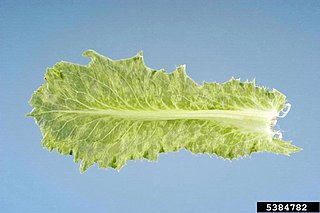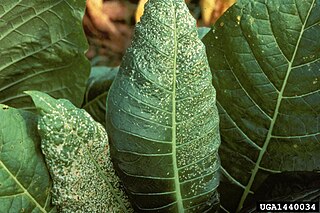
Juglans nigra, the eastern American black walnut, is a species of deciduous tree in the walnut family, Juglandaceae, native to North America. It grows mostly in riparian zones, from southern Ontario, west to southeast South Dakota, south to Georgia, northern Florida and southwest to central Texas. Wild trees in the upper Ottawa Valley may be an isolated native population or may have derived from planted trees.

A leaf spot is a limited, discoloured, diseased area of a leaf that is caused by fungal, bacterial or viral plant diseases, or by injuries from nematodes, insects, environmental factors, toxicity or herbicides. These discoloured spots or lesions often have a centre of necrosis. Symptoms can overlap across causal agents, however differing signs and symptoms of certain pathogens can lead to the diagnosis of the type of leaf spot disease. Prolonged wet and humid conditions promote leaf spot disease and most pathogens are spread by wind, splashing rain or irrigation that carry the disease to other leaves.
The potato spindle tuber viroid (PSTVd) was the first viroid to be identified. PSTVd is a small, single stranded circular RNA molecule closely related to the chrysanthemum stunt viroid. Present within the viroidal RNA is the Pospiviroid RY motif stem loop common to its genus. The natural hosts are potatoes and tomatoes. All potatoes and tomatoes are susceptible to PSTVd and there is no form of natural resistance. Natural infections have also been seen in avocados and infections in other solanaceous crops have been induced in the laboratory. Until 2017 PSTVd was thought to be unable to infect Solanum sisymbriifolium. Then in May seeds exported by a Dutch company were noticed to be infected. These seeds were shipped from the company, but had been originally bred to their specifications in two Asian countries. Pstv also causes Tomato bunchy top and is seed transmitted in tomato. it contains single stranded RNA without protein coat.

Plum pox, also known as sharka, is the most devastating viral disease of stone fruit from the genus Prunus. The disease is caused by the plum pox virus (PPV), and the different strains may infect a variety of stone fruit species including peaches, apricots, plums, nectarine, almonds, and sweet and tart cherries. Wild and ornamental species of Prunus may also become infected by some strains of the virus.

Lettuce mosaic virus (LMV) is a typical potyvirus, which causes one of the major virus diseases of lettuce crops worldwide.

Potato leafroll virus (PLRV) is a member of the genus Polerovirus and family Solemoviridae. The phloem limited positive sense RNA virus infects potatoes and other members of the family Solanaceae. PLRV was first described by Quanjer et al. in 1916. PLRV is transmitted by aphids, primarily the green peach aphid, Myzus persicae. PLRV is one of the most important potato viruses worldwide but particularly devastating in countries with limited resources and management. It can be responsible for individual plant yield losses of over 50%. One estimate suggests that PLRV is responsible for an annual global yield loss of 20 million tons. Symptoms include chlorosis, necrosis and leaf curling.
Arabis mosaic virus is a viral plant pathogen that is known to infect multiple hosts. The pathogen, commonly referred to as ArMV, is from the family Secoviridae, and it causes yellow dwarf of raspberry and is one of the causes of mosaic of rhubarb. Arabis mosaic virus infects multiple hosts, including strawberries, hops, hemp, grape, geraniums, raspberries, sugar beets, celery, horseradish, lilac, peach, and lettuces.
Bean pod mottle virus, or BPMV, is a species of plant pathogenic virus in the family Secoviridae. It is known to infect soybean crops.

Bidens mottle virus (BiMoV) is a pathogenic plant virus in the plant virus family Potyviridae. BiMoV is a flexuous filamentous particle, 720 nm long, and belongs to the Potyviridae genus Potyvirus. Like other viruses in this genus, Bidens mottle virus is transmitted both mechanically by sap and by aphids in a stylet-borne fashion.
Cherry mottle leaf virus (CMLV) is a plant pathogenic virus causing leaf rot. It is closely related to the peach mosaic virus.

Cucumber mosaic virus (CMV) is a plant pathogenic virus in the family Bromoviridae. This virus has a worldwide distribution and a very wide host range, having the reputation of the widest host range of any known plant virus. It can be transmitted from plant to plant both mechanically by sap and by aphids in a stylet-borne fashion. It can also be transmitted in seeds and by the parasitic weeds, Cuscuta sp. (dodder).

Prunus necrotic ringspot virus (PNRSV) is a plant pathogenic virus causing ring spot diseases affecting species of the genus Prunus, as well as other species such as rose and hops. PNRSV is found worldwide due to easy transmission through plant propagation methods and infected seed. The virus is in the family Bromoviridae and genus Ilarvirus. Synonyms of PNRSV include European plum line pattern virus, hop B virus, hop C virus, plum line pattern virus, sour cherry necrotic ringspot virus, and peach ringspot virus.

Tobacco etch virus (TEV) is a plant virus in the genus Potyvirus and family Potyviridae. Like other members of the genus Potyvirus, TEV has a monopartite positive-sense, single-stranded RNA genome surrounded by a capsid made from a single viral encoded protein. The virus is a filamentous particle that measures about 730 nm in length. It is transmissible in a non-persistent manner by more than 10 species of aphids including Myzus persicae. It also is easily transmitted by mechanical means but is not known to be transmitted by seeds.

Strawberry vein banding virus (SVBV) is a plant pathogenic virus and a member of the family Caulimoviridae.

Citrus psorosis ophiovirus is a plant pathogenic virus infecting citrus plants worldwide. It is considered the most serious and detrimental virus pathogen of these trees.

Celery mosaic virus (CeMV) is a plant pathogenic virus in the genus Potyvirus and the virus family Potyviridae .
Little cherry disease or LChD, sometimes referred to as little cherry, K & S little cherry or sour cherry decline, is a viral infectious disease that affects cherry trees, most notably sweet cherries and sour cherries . Little cherry disease should not be confused with cherry buckskin disease, which is caused by Phytoplasma. Note that both diseases are among the diseases referred to as cherry decline.
Blueberry shock virus (BlShV) is an Ilarvirus belonging to the Bromoviridae family. The Bromoviridae family contains single-stranded, positive-sense RNA viruses. Virus particles are icosahedral and 30 nm in diameter. Blueberry shock virus causes shock of blueberries in Oregon, Washington, and British Columbia. It gets its name because plants are shocked by the initial infection, meaning the flowers and foliage blight and wilt in the early spring, right when the plant is in full bloom. BIShV was first discovered in a blueberry field containing highbush blueberry in Washington in 1991. It continued to spread to Oregon, Washington and British Columbia since that time. In 2009, the disease was found in a western Michigan field, and may be preset in Pennsylvania as of 2011. Since its discovery, eradication is in progress to eliminate the disease and reduce loss of yield from it.
Cocoa necrosis virus (CoNV) is a plant pathogenic virus of the genus nepovirus that infects Theobroma cacao en natura causing cacao necrosis disease. CoNV is considered synonymous with Strain S of cacao swollen shoot virus. Unlike Cacao swollen shoot virus, it is not transmitted by mealybugs nor vectored by aphids, beetles, or leafhoppers that also commonly infest cacao. It is serologically, distantly related to Tomato black ring virus and very distantly related to Grapevine chrome mosaic virus.
Carrot virus Y (CarVY) is a (+)ss-RNA virus that affects crops of the carrot family (Apiaceae), such as carrots, anise, chervil, coriander, cumin, dill and parsnip. Carrots are the only known crop to be infected in the field. Infection by the virus leads to deformed roots and discolored or mottled leaves. The virus is spread through insect vectors, and is currently only found in Australia.











